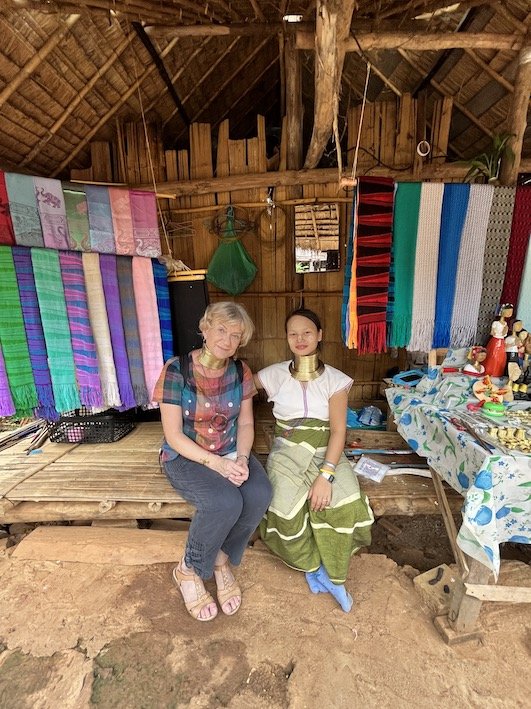Going Solo in Chiang Rai: Part 3
Helping People-In-Need Without Interfering in Culture or Beliefs
I have several meals at the two restaurants opposite Chiang Rai’s bus station. The visit to the hill tribes and the information around the walls of the BCM bakery cause me to reflect on different ways of ‘lending a hand’ when living abroad in response to people in need.
BaanChivitMai is a Scandinavian humanitarian mission founded in 1989 (www.bcmthai.com) and all of the profits from its bakery-restaurant go to supporting the centre that provides “a loving home, medical care and an education” to at-risk children; currently, mainly Burmese and hill tribe kids. There are lovely photos of happy children around the walls. You’ll see from the flyer below that the organisation’s charter “is based on the UN Convention on the Rights of the Child and promotes a Christian perspective”. The upside is that the children receive what’s promised: ‘a loving home, medical care and an education’. The centre’s director, who’s stopped by for a coffee today, tells me that BCM is always on the lookout for donations and assistance. He describes the successful inclusion of the centre’s children in the mainstream. The downside of missions promoting Christianity, many have argued, is that such an education away from their cultural environment leads children away from their heritage and so has the potential to create dissonance, as they grow up, between them and the life they’ve left behind (their families, culture and community belief systems). The mission’s concept of earning from a restaurant reminded me of a place I regularly dine in Chiang Mai called Free Bird. It also uses its profits to educate, and assist (in every way) Burmese refugee children and their families. The intention there, however, is to keep families and communities together, support their cultural heritage and not impose a ‘foreign’ faith like Christianity.
Below: BCM’s brochure showing happy recipients of the care and Christian education provided.
By way of comparison, the founder of the humanitarian venture Free Bird – and its associated school Freedom House in Chiang Mai – is Lisa Nesser, an extraordinary woman. Her dedication to serving communities in need goes back to her teens. She has since equipped herself not only with a formal education in teaching, human rights and media communication to document the plight of refugees, but also with the expertise to manage and develop an enviable establishment in which every detail is the result of her compassionate emotional and humanitarian EQ. Along with its school, the establishment houses a vegan restaurant (with more than a hint of Burmese influence), a sustainable produce and pre-loved items store as well as space for gatherings and events. Everything on the menu is delicious and new items are included regularly. What struck me most is their presentation: works of art. Lisa’s journey is worth reading and one place it can be found is in an article in City Life Chiang Mai, Aug. 1, 2562 (2019) by Pim Kemasingki. When in Chiang Mai, don’t forget to drop in at Free Bird. Try the the two dishes pictured on the left, they’re my favourites. The centre has become a meeting place for young expats, especially women belonging to the ‘Chiang Mai Nomad Girls’ an interesting and welcoming group who support the centre and meet there for lunch on Wednesdays.
Below: The menu and function room of Free Bird Cafe.
The different ‘methods’ of the two ventures highlighted the need for care when ‘helping’ those in other cultural contexts, even when convinced of one’s good intentions. That we, as Westerners, enjoy a privileged lifestyle in Asian countries where the monthly basic wage wouldn’t even get us to the end of the week back home, is something to keep in mind when balancing our spiritual (or karmic) ‘books’ in our eagerness to avail ourselves of advantages offered by lower costs. The happiest travellers and expats seem to engage and contribute to the communities that offer them a lifestyle not affordable back home.
Also in need of support are the hill tribe communities. Twelve kilometers outside Chiang Rai is our fourth and last stop, the Union of Hill Tribe Villages where the Akha, Yao, Lahu, Kayaw and Long Neck Karen are represented. They form part of an eco-tourism venture that’s been severely impacted by Covid restrictions. The small villages are down in a valley along a narrow track visitors share with chickens out for their afternoon stroll. Before venturing down to the tribes, visitors pay 300 baht at the entrance where they receive a brochure with map and a long pole to assist them in walking down the steep stairs, and in the rainy season, across the sodden red earth. Masks are still mandatory here because the isolated villagers are vulnerable. At the first building, I passed a woman chasing away a snake that was surveying her house as a possible abode. Up ahead the Akha village was fronted by the stalls of several women with neat displays of wares. I decided to buy something from as many stalls as I could. Nothing was going to break the bank and these people have had it tougher than most during Covid without their usual income from tourists. The Akha villagers treated me to a short musical performance and allowed me to take a photo of us together. Try as I might to make myself smaller for the photo, I still look like Gulliver among these tiny women. The brochure collected at the entrance states that there are some 65,000 Akha living in Thailand, mainly in places like Chiang Rai, Chiang Mai and Lampang. In total, just under one million hill tribe people live in Northern Thailand. Coincidentally, I’ve been buying ground Akha coffee each week for the past three months – for me, the best coffee in the world.
Below: A hill tribe village with a Yao women selling weaving and delicate embroidery
I purchase some items with delicate cross-stitching from the shy Yao vendor. The Yao seem more reserved than the more outgoing Akha, and have genetic ties to Tibet. The Lahu, Kayaw and Long Neck Karen, in contrast, are originally from Myanmar and recently more have sought refuge in Thailand having escaped from a government bent on their eradication. The hill tribes not only speak their first language but are often fluent in each other’s languages and dialects. If they learn Thai or English, these may become their fourth or fifth language. Although they’ve been able to apply for Thai citizenship for some decades, the process is too convoluted and difficult for most. This leaves them vulnerable to human trafficking and gives them no security as they cannot own land, seek employment, travel freely or access social welfare services and subsidized healthcare. Without citizenship, they are considered illegal residents who can easily be deported, even if born in Thailand. There are a number of organisations who assist them such as the International Justice Mission who have helped over 10,000 obtain a better future through citizenship which provides at its core, access to an education.
Below: The Akha making music with percussion instruments, a mud-brick house wall, a diagram showing the damage done to neck vertebrae by the fading tradition of wearing neck rings, and a covered area for storing rice.
Around the periphery of the thatched-roof dwellings are a vegetable farm, a rice farming school, a pineapple field, a pen for wild (black) boar, a chicken and egg farm, a rubber plantation, buffalo farm and a school.
My last stop is on the porch of a very pretty Karen Long Neck Girl. She lends me a set of ‘fake’ golden neck rings for a photo, and I purchase a bracelet and ring. Further along, another Karen woman sells me gifts for my grandchildren. She’s middle-aged and unsurprisingly doesn’t speak Thai, so I have a younger villager explain to her that I’d like my grandkids to have a photo of her holding one of their gifts so that they’ll appreciate its origin. As I leave, I’m aware that the impact of my visit and its paltry expenditure was embarrassingly inadequate in the face of the need that’s evident here.
Below: Images of Akha artisans adept at all sorts of handicrafts, a pretty Karen Long Neck woman who offered me a set of rings that opened at the back for the photo, and an older Karen woman holding one of the gifts for my grandkids.
Always on the lookout for music, in the evening I make my way to where young Thai’s hang out. It’s an entire street dedicated to clubs and bars. This is Chiang Rai’s music scene and I visit three of the many recommended on online tourist sites. Of those, ‘The Library’ was most funky: flashing red and blue lights, loud music, tattooed young men, and women in low-cut, tight dresses. No Farangs (foreigners) here and certainly no grandmothers, except me - one blonde grandma that had many of the young crowd do a double-take. Several came to offer me chair. ‘How kind, thank you, but I’d rather dance!’
Next, is a day trip to the Golden Triangle: stay tuned for Part 4…














